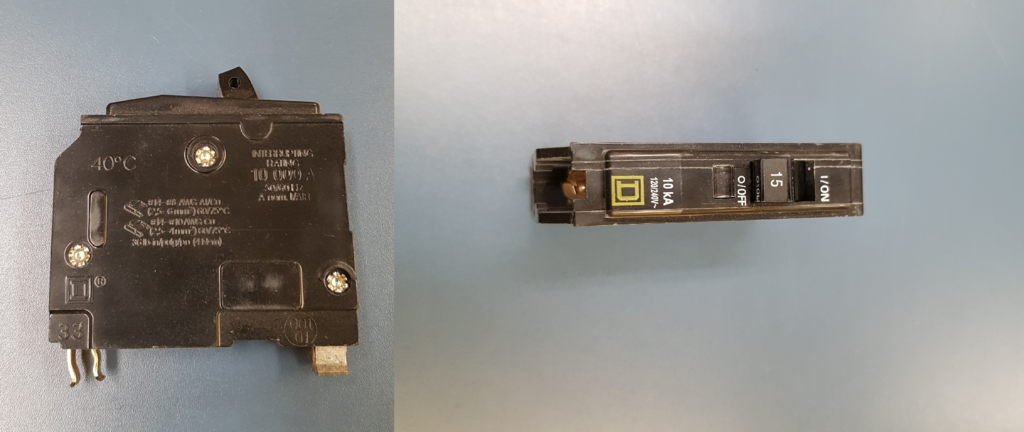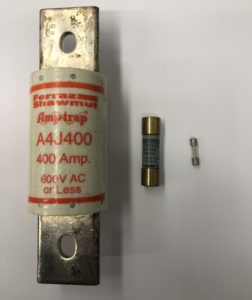Electrical Terms and Definitions
3 Overload and Overcurrent Protection Devices
Click play on the following audio player to listen along as you read this section.
Fuses and Circuit Breakers

A circuit breaker is an electromechanical device designed to automatically open one or more ungrounded circuit conductors in the event of a fault. They use thermal action and a bi-metallic strip to protect from overload conditions, and a magnetic sensing coil to protect against overcurrent situations. The main advantage that circuit breakers have over fuses is that they are re-settable.

A fuse is a simple device that protects the conductors and equipment of a circuit from damage due to higher than normal fault values. It is designed to be the weakest link in a circuit. It is an insulated tube containing a strip of conductive metal (fuse-link) that has a lower melting point than either copper or aluminum. The fuse link has narrow, resistive segments that concentrate the current and cause the temperature at those points to rise.
During a short circuit the fuse elements burn open in just a fraction of a second. The higher the values of fault current, the faster the fuse will react. In an overload situation, the fuse elements can take many seconds or even minutes before thermal actions cause the fuse link to melt open.
Fuses come in two categories: Fast-acting fuses (Type P) and time-delay fuses (Type D). Fuses used in motor circuits have to withstand the intense inrush current when the motor is first started, and so we install time-delay fuses, also known as “dual-element fuses” in those circuits.
Common Ratings
All overcurrent devices must be operated within their rated values. Three of the most important ratings are voltage, current, and interrupting capacity.
Voltage rating
Fuses and circuit breakers must be rated for at least the value of the voltage of the circuit they are designed to protect.
When a fuse or circuit breaker interrupts a fault current, it must safely extinguish the arc and prevent it from reestablishing itself. Therefore, the voltage rating of a fuse or circuit breaker must be equal to or greater than the system voltage.
For example, a fuse rated at 240V RMS will be acceptable for use in a 120V circuit. However, it would exceed the fuse’s voltage rating to use it in a 600V circuit.
Continuous-duty rating
Continuous-duty rating describes the maximum rated value of RMS current that the overcurrent device is designed to handle on a continuous basis without tripping. Generally speaking, the ampere rating of the fuse or breaker should not exceed the current carrying capacity of the circuit, but there are exceptions, such as certain motor circuits.
Unless otherwise marked, the continuous-duty rating of fuses and circuit breakers is 80% of their marked ampere value. This means that a standard 15 amp circuit breaker is generally designed for use in a maximum 12 amp circuit.
Interrupting capacity
When a short circuit or ground fault occurs, the circuit resistance drops to effectively zero ohms, causing very large values of current to flow. This extremely fast rise in fault current can cause damage to wires and equipment through overheating and must be extinguished as quickly as possible.
The interrupting-capacity (IC) rating of an overcurrent device is the maximum fault current that the device can interrupt without damage to itself. Most circuit breakers and fuses have an IC rating of 10,000 amps.
For systems capable of larger fault currents, high-rupture capacity (HRC) fuses can interrupt currents up to 200,000 amps by using arc-quenching fillers such as silica sand to help interrupt the fault current.
Text Attributions
- This chapter was adapted from “Overload and Overcurrent Protection” in Basic Motor Control by Chad Flinn and Aaron Lee, which is under a CC BY 4.0 Licence. Adapted by Aaron Lee.
An automatic device that is designed to safely disconnect circuits under fault conditions. Most circuit breakers provide Overload and Overcurrent protection, and are rated in Volts, Amps and Horsepower.
An insulated tube containing a strip of conductive metal that has a lower melting point than either copper or aluminum. It protects a circuit from damage because it will melt in overload or overcurrent situations and break the connection with the rest of the circuit.
The difference in electric potential between two points, which is defined as the work needed per unit of charge to move a test charge between the two points. It is measured in volts (V).
The rate of flow of an electric charge, measured in amperes (or amps). When one coulomb of charge moves past one point in once second, current is said to flow at a rate of one ampere. Current flows from negative potential to a positive potential through a load.
The maximum fault current that an overcurrent device can interrupt without damage to itself. Most circuit breakers and fuses have an IC rating of 10,000 amps.
The maximum amount of voltage that a fuse, circuit breaker, switch-gear or motor starter can handle. The voltage rating of a fuse or circuit breaker must be equal to or greater than the system voltage.
The maximum rated value of RMS current that the overcurrent device is designed to handle on a continuous basis without tripping.
The unit used to measure electrical current. It is equal to a flow of one coulomb per second. It may also be called "amp."
The unit used to measure electrical resistance (Ω). It takes one volt to push one amp through one ohm of resistance.

